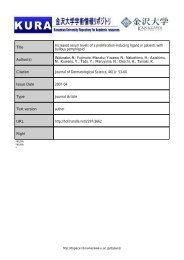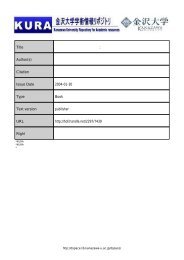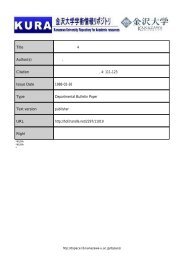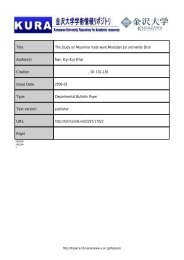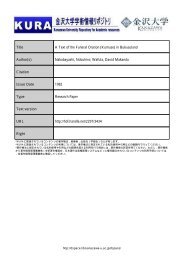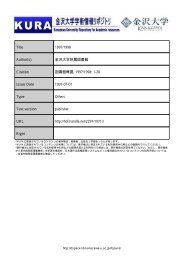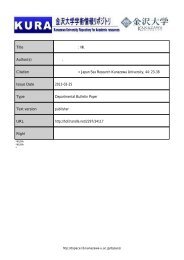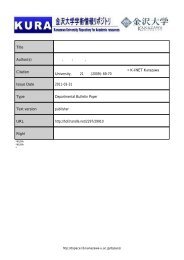Petrology of the Yugu peridotites in the Gyeonggi Massif, South Korea
Petrology of the Yugu peridotites in the Gyeonggi Massif, South Korea
Petrology of the Yugu peridotites in the Gyeonggi Massif, South Korea
You also want an ePaper? Increase the reach of your titles
YUMPU automatically turns print PDFs into web optimized ePapers that Google loves.
M<strong>in</strong>eral/Chondrite<br />
M<strong>in</strong>eral/Chondrite<br />
100<br />
10<br />
1<br />
0.1<br />
0.01<br />
100<br />
10<br />
1<br />
0.1<br />
0.01<br />
(a)<br />
Cpx <strong>in</strong> Avacha peridotite<br />
Amph <strong>in</strong> Avacha peridotite<br />
La Ce Pr Nd Sm Eu Gd Tb Dy Ho Er Tm Yb Lu<br />
(d)<br />
Amp<br />
Amp<br />
Opx<br />
Cpx <strong>in</strong> Avacha xenolith<br />
Cpx<br />
K25<br />
Amph <strong>in</strong> Avacha peridotite<br />
Opx<br />
Cpx<br />
K25<br />
La Ce Sr Pr NdZr SmEuGdTi Tb Dy Y HoEr TmYbLu<br />
barely changed dur<strong>in</strong>g <strong>the</strong> subsolidus stage (Arai<br />
1994). The <strong>Yugu</strong> <strong>peridotites</strong> have been probably<br />
derived from <strong>the</strong> sub-arc or abyssal upper mantle<br />
overla<strong>in</strong> by a relatively th<strong>in</strong> crust (Arai 1991).<br />
The <strong>Yugu</strong> <strong>peridotites</strong> are similar <strong>in</strong> primary petrological<br />
character to <strong>the</strong> <strong>peridotites</strong> from Bibong<br />
and Baekdong <strong>of</strong> <strong>the</strong> same area (Seo et al. 2005)<br />
(Fig. 4). Dunites and harzburgites have been also<br />
reported from <strong>the</strong> Bibong and S<strong>in</strong>gok areas adjacent<br />
to <strong>the</strong> <strong>Yugu</strong> area (Song et al. 1997; Song &<br />
Song 2001; Seo et al. 2005). These <strong>peridotites</strong> have<br />
been highly altered and metamorphosed to<br />
amphibolite to granulite facies, and thus, <strong>the</strong>ir protoliths<br />
should be carefully determ<strong>in</strong>ed. The high<br />
Cr# character, from 0.5 to 0.6, <strong>of</strong> relic sp<strong>in</strong>els probably<br />
<strong>in</strong>dicates that <strong>the</strong> S<strong>in</strong>gok <strong>peridotites</strong> are<br />
largely harzburgites (Song & Song 2001). This<br />
Cr# <strong>of</strong> sp<strong>in</strong>el is very similar to that <strong>of</strong> <strong>the</strong> <strong>Yugu</strong><br />
harzburgite. This k<strong>in</strong>d <strong>of</strong> harzburgite is quite<br />
common <strong>in</strong> <strong>the</strong> ophiolitic mantle (Arai et al. 1990),<br />
(b)<br />
La Ce Pr Nd Sm Eu Gd Tb Dy Ho Er Tm Yb Lu<br />
(e)<br />
Opx<br />
Opx<br />
Amp<br />
Cpx<br />
Amp<br />
Cpx<br />
UK<br />
UK<br />
La Ce Sr Pr NdZr SmEuGdTi Tb Dy Y HoEr TmYbLu<br />
Peridotites from <strong>Yugu</strong>, <strong>Korea</strong> 495<br />
(c) K18<br />
Amp<br />
Cpx<br />
Opx<br />
Cpx <strong>in</strong> abyssal peridotite<br />
La Ce Pr Nd Sm Eu Gd Tb Dy Ho Er Tm Yb Lu<br />
(f)<br />
Amp<br />
Cpx<br />
Opx<br />
La Ce Sr Pr NdZr SmEuGdTi Tb Dy Y HoEr TmYbLu<br />
Fig. 7 (a–c) Chondrite-normalized REE and (d–f) multi-element patterns <strong>of</strong> Amph, amphiboles; Cpx, cl<strong>in</strong>opyroxenes; Opx, orthopyroxenes <strong>in</strong> peridotite<br />
samples (K25, UK, K18). Chondrite values are from Sun and McDonough (1989). REE abundances are clearly different between <strong>the</strong> m<strong>in</strong>erals. Note that <strong>the</strong><br />
cl<strong>in</strong>opyroxene enclosed by an orthopyroxene porphyroclast (Cpx <strong>in</strong> Opx) <strong>in</strong> K18 has relatively high-REE abundances (grey thick l<strong>in</strong>es <strong>in</strong> c,f). Closed and<br />
open symbols are core and rim <strong>of</strong> each gra<strong>in</strong>, respectively. Ranges <strong>of</strong> cl<strong>in</strong>opyroxenes and pargasitic amphiboles <strong>in</strong> a harzburgite xenolith (#277), strongly<br />
metasomatized by slab-derived fluids, from Avacha Volcano, Kamchatka (Ishimaru et al. 2007) are <strong>in</strong>dicated <strong>in</strong> (a,b). The range for cl<strong>in</strong>opyroxenes <strong>in</strong><br />
abyssal <strong>peridotites</strong> (Kelemen et al. 1995) is also shown for comparison.<br />
<strong>in</strong>dicat<strong>in</strong>g <strong>the</strong>ir derivation from <strong>the</strong> ocean floor to<br />
arc mantle (Dick & Bullen 1984; Arai 1994).<br />
METASOMATIC MODIFICATION OF YUGU PERIDOTITE<br />
K18<br />
Almost all cl<strong>in</strong>opyroxenes and amphiboles are <strong>in</strong><br />
equilibrium <strong>in</strong> terms <strong>of</strong> REEs (Fig. 7). Enrichment<br />
<strong>of</strong> light REEs and Sr relative to heavy REEs<br />
<strong>in</strong> amphiboles and pyroxenes, especially <strong>in</strong> orthopyroxenes,<br />
strongly suggests metasomatic modification<br />
<strong>of</strong> <strong>peridotites</strong> by a fluid or fluids. The<br />
<strong>in</strong>volved fluid is possibly similar <strong>in</strong> chemistry to<br />
slab-derived fluids (Maury et al. 1992). The REE<br />
and trace-element distribution patterns <strong>of</strong> cl<strong>in</strong>opyroxenes<br />
and amphiboles <strong>of</strong> <strong>the</strong> <strong>Yugu</strong> <strong>peridotites</strong><br />
are approximately similar to those <strong>in</strong> peridotite<br />
xenoliths from <strong>the</strong> Avacha Volcano, Kamchatka<br />
Arc, which are representative <strong>of</strong> <strong>the</strong> mantle wedge<br />
material beneath a volcanic front (Fig. 7) (Ishimaru<br />
et al. 2007; Ishimaru & Arai 2008). The <strong>Yugu</strong><br />
© 2008 The Authors<br />
Journal compilation © 2008 Blackwell Publish<strong>in</strong>g Asia Pty Ltd




